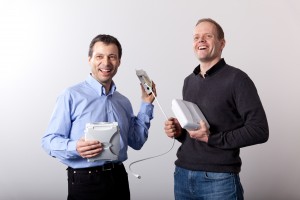Wireless Service Quality
WLAN (Wireless Local Area Network) or Wi-Fi is an offshoot of the ETH World project. In recent years, the IT Services, commissioned by ETH Zurich, has been continuously expanding WLAN coverage at ETH. Lecture halls, meeting rooms and public areas are now all covered by wireless network. Wi-Fi was intended and is still meant as a supplementary service without high availability, supported by few resources (0.8 FTEs). However, perception and demands of the service have changed considerably in the last three years. This was triggered primarily by the new category of smart phones and is being currently reinforced by a new generation of tablets and eReaders. While in 2009 we had about 1000 to 2000 simultaneously active Wi-Fi devices we hit a new record in the current semester with 9200 simultaneously logged on devices. Thankfully, the increased load in terms of bandwidth on the core network doesn’t pose much of a problem.
More users means less all around
The load on the authentication and authorization infrastructure (RADIUS) and at times high concentration on individual Access Points (AP), result in increased stress for a shared medium. For frequency reasons, a maximum of four APs can be installed in one room. Technically, a single AP has a fixed maximum bandwidth which all its users must share.
Water causes wireless interference
In a lecture hall with 200 users not much bandwidth is available per user, considering that the human body is made mostly of water and Wi-Fi rays are absorbed on a microwave basis. Since WLAN transmits on the 2.4 GHz frequency – the resonant frequency of water, it’s rays are easily absorbed wherever water is found e.g. large public gatherings, house plants or damp walls.
Shortage of IPv4- addresses
Due to the enormous growth in demand, there is also the additional problem of a shortage of IPv4– addresses. ETH Zurich currently has only a very small reserve of IPv4 addresses. In fact since the past September there are no IPv4 address domains available throughout Europe (RIPE-NCC) anymore. Because its successor, the IPv6 protocol, is hardly being implemented in Internet by service providers, there seems to be no real alternative for the moment.
Counter Measures
Thomas Lier, Derk-Jan Valenkamp and Armin Wittmann make every effort to ensure optimal WLAN reception at ETH Zurich.
The IT Services has taken the following measures in order to counter all these problems:
- Frequency separate SSID’s (Service Set Identifier) public and public-5, as well as eth and eth-5 help achieve a stable connection (2.4GHz or 5GHz) and allow better support assistance. Each user can individually select the frequency band best suited to his needs.
- New hardware for the RADIUS servers has considerably improved performance of authentication and authorization
- Improved distribution of RADIUS requests to all servers and timeout adjustments further boosted performance
- Timeout adjustments on the DHCP server has allowed to temporarily retrieve unnecessarily occupied IPv4 addresses
- Equipment of all large auditoriums with multiple APs
- APs can also be installed and operated in offices if required
- For enhanced capacity management the throughput and number of users on each AP is being monitored
- Implementation of a PAT project in order to solve the IPv4 shortage problem (productive by Summer 2013)
- Consistent recovery of definitely unused IPv4 domains from departments and other users
- IPv6 pilot project so that internal service providers (storage, mail, WCMS) get an opportunity to study IPv6
- Accelerated replacement of old APs, some of them 8 years old, by the latest generation of devices with the 802.11n-Standard (completed)
WLAN vs LAN
All these measures will certainly have some effect. Nevertheless, we must take into account that technically, in terms of reliability and connectivity, Wi-Fi will never reach the level of a wired connection. Too much diversity (BYOD – variety of terminal manufacturers) and errors (foreign or rough APs, Bluetooth, microwaves and metal-based barriers) affect the connection quality. High-performance, guaranteed bandwidth and reproducible error analysis can only be achieved with wired LAN.
Wi-Fi – WLAN
Related Posts in the ITS Blog
Posted on
in News English



